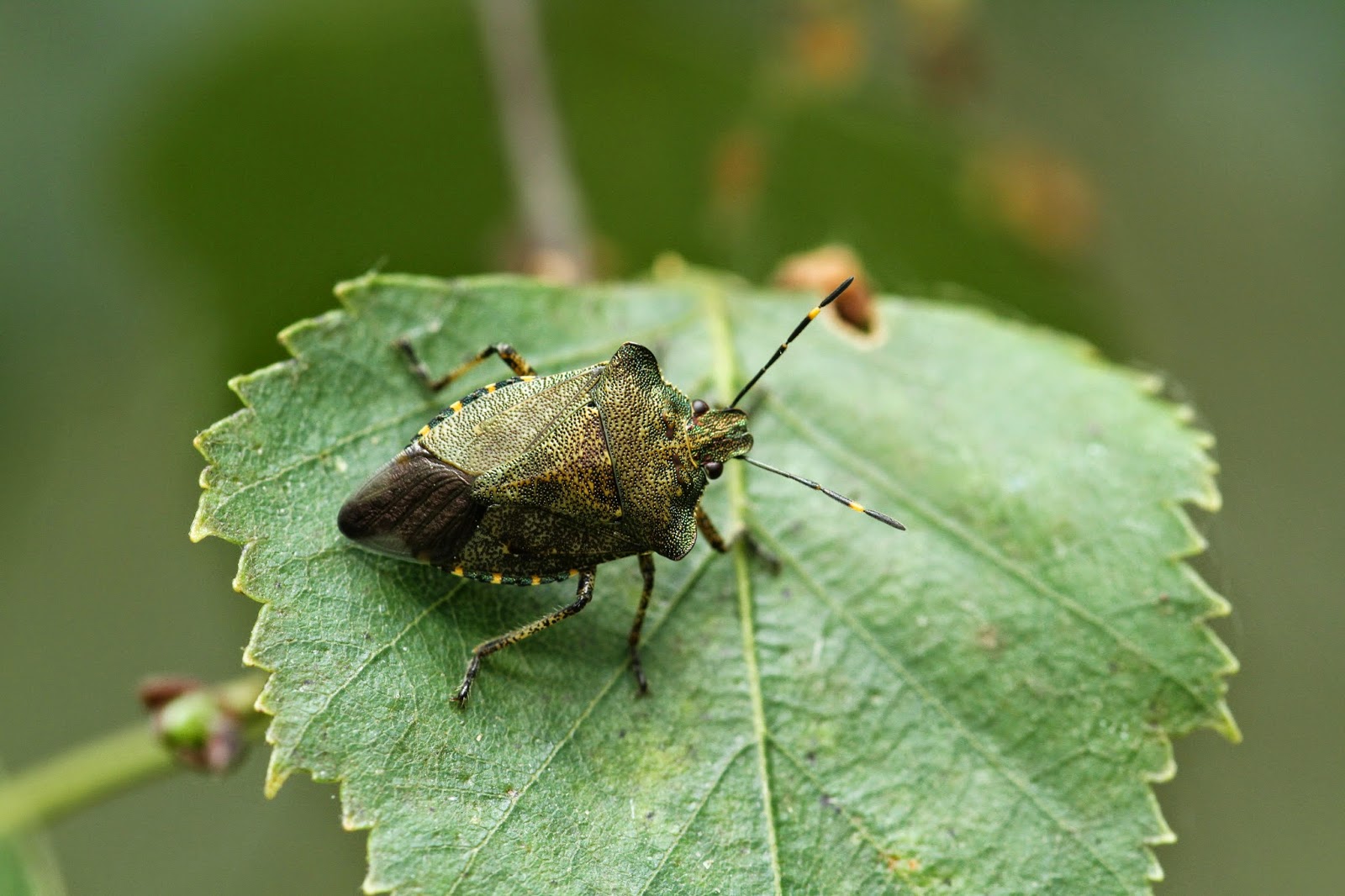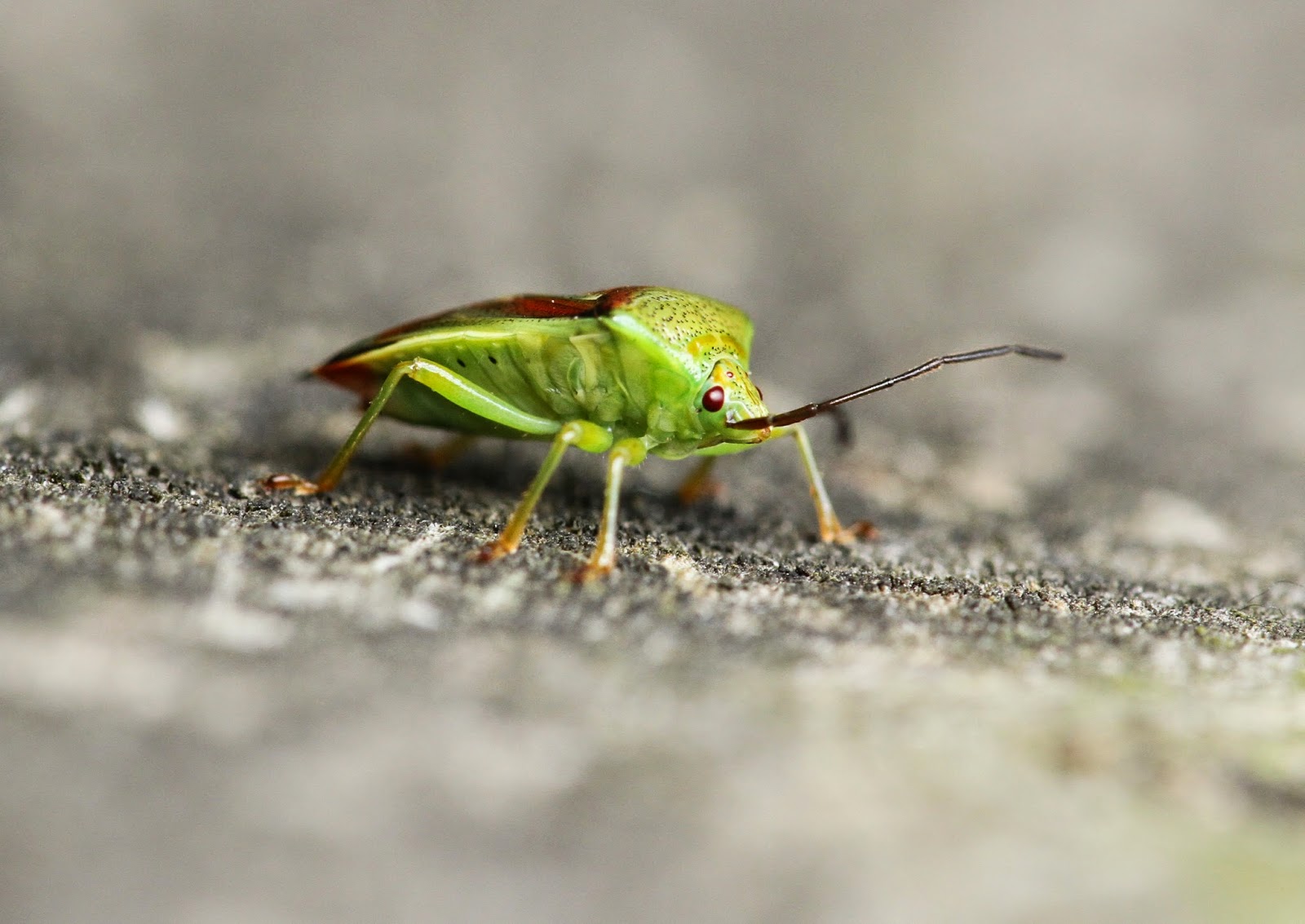Shield Bugs are attractive insects with their bright
colouring, and are easily characterised by their flattened oval-shaped shell,
with a triangular plate which sits between the wing cases, this is called the
scutellum, meaning ‘small-shield’, which gives Shield Bugs their name. They are
also known as Stink Bugs due to their ability to produce a foul smelling liquid
from special glands near their legs, when threatened. The majority of species
(46 in total) feed on plant sap, however some are predatory, such as the Bronze
and Red-legged Shield Bugs which feed on caterpillars and other insects.
The predatory Red-legged Shield Bug - T.Ellers - 26/08
Recently we mentioned about the number that we had come
across one morning on Skipwith Common NNR, with five different species found.
Starting along the boardwalk adjacent to the bomb bay loop, here we found a
number of Bronze Shield Bug (Troilus luridus) and Birch Shield Bug (Elasomostethus interstinctus)
– all present on either willow or birch trees. Amongst them were also several
nymphs of each species. When hatched Shield Bugs pass through several moults
(five in total), changing colour and shape and resembling more like the adults
at each stage until they reach the final breeding stage. When they are in the
early stages, known as ‘instars’ identifying them can test even the most
knowledgeable observer!
The nymph of a Bronze Shield Bug - Skipwith Common - 18/08
Several weeks prior to this visit we’d come across the nymph
of a Bronze Shield Bug in the same place, which was a good find with it being a
new species for the valley. So it was pleasing to return this time and find
some of the adults, which are a rather striking species and stand out from some
of the other Shield Bugs due to their metallic colouring. They also have a
single yellow marking on either antennae, another good I.D feature to look for.
Bronze Shield Bugs are likely to be found on deciduous trees, and are a
carnivorous species which feed on small insects. New adults emerge from August
onwards, before over-wintering and emerging in late spring to mate.
Bronze Shield Bug adult - Skipwith Common - 18/08
Bronze Shield Bug nymph - Skipwith Common - 18/08
Birch Shield Bugs were far more numerous than Bronze, with
at least 25 counted on this visit. As their name suggests they were primarily
found on Silver Birch, but we also came across a number of individuals on Salix (willow species). Several nymphs
were also found, with these being quite distinctive with their bright green and
red markings. The adult bares resemblance to the Hawthorn Shield Bug, but is
smaller and lacks the broad brown/reddish markings and has more of a
bluey/green colouring. This species is likely to be found throughout woodlands,
parks and gardens, the adults over-winter, before re-emerging in spring to lay their
eggs, the new group of adults then start to appear from August onwards. Over
the last few weeks there definitely seems to have been a sudden emergence on
the Common.
Birch Shield Bug adult - Skipwith Common - 18/08
Birch Shield Bug nymph - Skipwith Common - 18/08
Birch Shield Bug adult - Skipwith Common - 18/08
Nearby we searched the area of Gorse where we then came
across Red-legged (or Forest) Shield Bug
(Pentatoma rufipes) and Gorse Shield Bug (Piezodorus lituratus). Gorse Shield Bugs can be easily
distinguished by the blue and yellow edge to the abdomen, and the dark
purple/red colouring and bright red antennae. This species is likely to be
found on heathlands, scrublands and commons, primarily where its food plants Broom
and Gorse grow, the latter being where the majority of them were found,
including many nymphs, pictured below. Earlier in the year during the spring
this species is bright green with blue-edged wing cases, from August young adults then emerge with their purple/red markings, which darken prior to
hibernation. We’ve seen a huge emergence over the last few weeks with high
counts recorded, found singly on the Gorse (and also nearby Silver Birch), but
also many were found in ‘clumps’ on top of each other.
Gorse Shield Bug adult - Skipwith Common - 18/08
Gorse Shield Bug adult - Skipwith Common - 18/08
Gorse Shield Bug nymph - Skipwith Common - 18/08
Adults piled high - Skipwith Common - 18/08
The Red-legged Shield Bug was definitely one of the most
striking species seen on this visit, and with its bright colours it stood out a
mile amongst the Gorse, carefully balancing on the end of a spike with its long
legs. Red-legs are a predatory species, which feed on caterpillars and other
insects, as well as fruits. The adults can be seen occasionally in early
spring, however usually from July until late autumn. This species over-winters
as young larvae which are likely to be found mainly on deciduous trees such as
Oak, Silver Birch, Alder and Hazel. This species has two colour forms, one with
bright red-legs and antennae, the other has a much darker brown abdomen with a patterned yellow edge,
and the pale spot on the back can vary between orange and cream. We were fortunate enough
to come cross both colour variations on this visit, pictured below.
Red-legged Shield Bug - Skipwith Common - 18/08
Red-legged Shield Bug - Skipwith Common - 18/08
Red-legged Shield Bug - Skipwith Common - 18/08
Pair of Red-legged Shield Bugs - Skipwith Common - 18/08
To finish off, on the walk back to the van along the ditch
side amongst the Juncus we found a single Hawthorn Shield Bug (Acanthosoma haemorrhoidale), unfortunately it flew off promptly so no photo! The
Hawthorn Shield Bug is a bright apple green colour, with broad dark brown/red
markings on the abdomen, the abdomen is also tipped red which helps to separate
it from the similar Birch Shield Bug. The name suggests that this species will
be found on Hawthorn, however we are yet to find it on Hawthorn, species such
as Hazel, Holly, Oak and Dogwood are other hot-spots. They over-winter
underneath bark, leaf litter etc and emerge in early spring, by late summer the
new brood of adults emerge.
It was pleasing to find five species on the Common, and in
good numbers, particularly Gorse Shield Bugs. Earlier that week we had also
found Hairy (or Sloe) Shield Bug (Dolycoris baccarum) at Thornton Ellers
and Green Shield Bug (Palomena prasina) nymphs, no adults as
of yet, but with the number of nymphs recorded there should soon be a great
deal of adults to look for. Hairy Shield Bugs are not as common as the others
mentioned here, so to find two at Thornton Ellers this year has been a good
result, and another new species for the valley. As their name suggests this
species can be easily distinguished by the long hairs which stand out. They also have rather striking antennae with black and white
markings, which also match the edges of the abdomen. Found both times on
Bramble which is one of their favoured shrubs, however the larvae particularly
favour Blackthorn and those in the Rosacea
family. This species over-winters as an adult, emerging in the spring, the new
generation of adults can often be found from August onwards.

Hiding...
& again....
Finally in the open - Hairy Shield Bug adult - T.Ellers - 26/08
A number of Green Shield Bug nymphs were found in the same
area at Thornton Ellers, with at least seven just along one hedgerow, usually
on the nettle leaves. Green Shield Bugs are a bright green colour in summer,
before turning to brown throughout the winter prior to hibernation. Another sap
feeder they are likely to be found in parks and gardens on a variety of
deciduous trees, but Hazel is a typically favoured species. Females
appear in May, after hibernating in grass tussocks and leaf litter, by June
they will have found a male to mate with. Females lay ‘batches’ of eggs,
with around 28 in each, with a number of batches laid each female can lay up to
100 eggs, these go on to become the new generation of adults which we are
likely to see from September onwards.
Green Shield Bug nymph, 3rd instar - T.Ellers - 26/08
Green Shield Bug nymph, 4th instar - T.Ellers - 26/08
Green Shield Bug nymph, 5th instar - T.Ellers - 26/08
Over the last few weeks the Common has really been producing
the goods with many other invertebrates found whilst looking for Shield Bugs - more on this another day!





















fantastic, great I D guide to shield bugs. Spot on team.
ReplyDelete